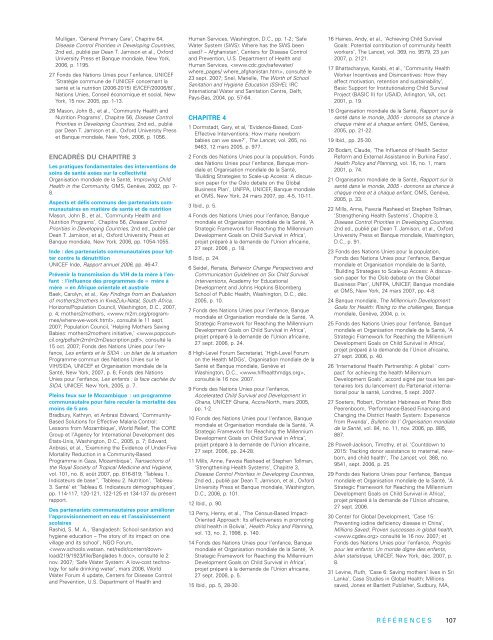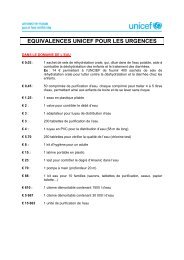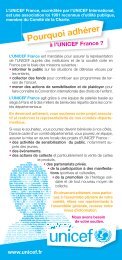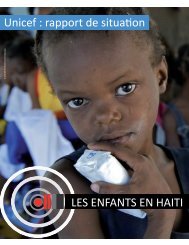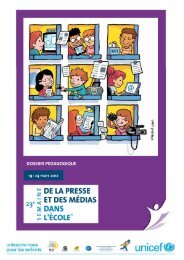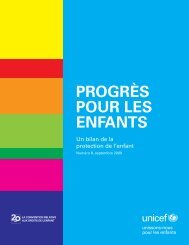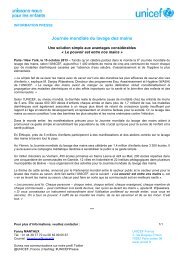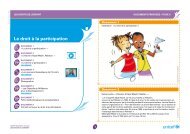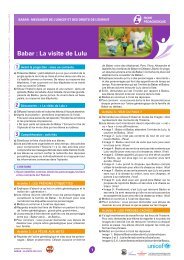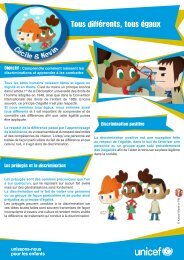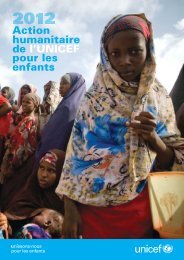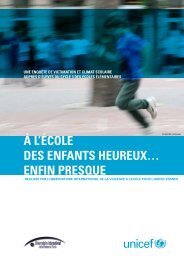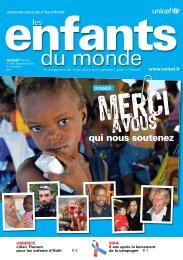Journées nationa<strong>le</strong>s de vaccination et journées dela santé de l’enfantLevine, Ruth, ‘Case 4: Reducing Child Mortality withVitamin A in Nepal’, Chapitre 4, Case Studies inGlobal Health: Millions saved, Jones et Bart<strong>le</strong>ttPublishers, Sudbury, MA, 2007; Initiative mondia<strong>le</strong>pour l’éradication de la poliomyélite, ‘Journées nationa<strong>le</strong>sde la vaccination’,, consulté <strong>le</strong> 24 août. 2007; Fonds <strong>des</strong> NationsUnies pour l’enfance, Rapport annuel 2006, UNICEF,New York, juin 2007, p. 12, et 1946–2006: Soixanteans au service <strong>des</strong> <strong>enfants</strong>, nov. 2006, pp. 18-19.Financement du secteur de la santé : approchessectoriel<strong>le</strong>s et initiative en faveur <strong>des</strong> pays pauvrestrès endettésGottret, Pablo, et George Schieber, Health FinancingRevisited: A practitioner’s guide, Banque mondia<strong>le</strong>,Washington, D.C., 2006; Schieber, George, et al.,‘Financing Health Systems in the 21st Century’,Chapitre 12, Disease Control Priorities in DevelopingCountries, 2nd ed., publié par Dean T. Jamison, et al.,Oxford University Press et Banque mondia<strong>le</strong>,Washington, D.C., 2006, pp. 225-242; Banque mondia<strong>le</strong>,‘Services de santé et de nutrition’, Chapitre 8,Banque mondia<strong>le</strong>, Rapport sur <strong>le</strong> développement<strong>dans</strong> <strong>le</strong> <strong>monde</strong>, 2004 : <strong>des</strong> services pour <strong>le</strong>s pauvres,Banque mondia<strong>le</strong> et Oxford University Press,Washington, D.C., 2003, pp. 133-156.Prise en charge intégrée <strong>des</strong> maladies néonata<strong>le</strong>set infanti<strong>le</strong>s en IndeRamji, Siddarth, ‘Integrated Management of Neonataland Childhood Illness (IMNCI): Imp<strong>le</strong>mentation chal<strong>le</strong>ngesin India’, Indian Pediatrics, vol. 43, no. 12, 17déc., 2006, pp. 1029-1031; Sines, Erin, Anne Tinkeret Julia Ruben, ‘The Maternal-Newborn-Child HealthContinuum of Care: A col<strong>le</strong>ctive effort to save lives’,Policy Perspectives on Newborn Health, Save theChildren et Population Reference Bureau,Washington, D.C., mars 2006, p. 2.L’Initiative de BamakoEbrahim, G. J., ‘The Bamako Initiative’, Journal ofTropical Pediatrics, vol. 39, no. 2, 1993, pp. 66-67;Knippenberg, Rudolf, et al., ‘Imp<strong>le</strong>mentation of theBamako Initiative: Strategies in Benin and Guinea’,International Journal of Health Planning andManagement, vol. 12, no. S1, 1997, pp. S29-S47;Küch<strong>le</strong>r, Von Felix, ‘Manageab<strong>le</strong> Bamako InitiativeSchemes’, Bul<strong>le</strong>tin von Medicus Mundi Schweiz, no.84, avril 2002; Paganini, Agostino, ‘The BamakoInitiative Was Not about Money’, Health Policy andDevelopment, vol. 2, no. 1, 2004, pp. 11-13; Banquemondia<strong>le</strong>, Rapport sur <strong>le</strong> développement <strong>dans</strong> <strong>le</strong><strong>monde</strong>, 2004 : <strong>des</strong> services pour <strong>le</strong>s pauvres,Banque mondia<strong>le</strong> et Oxford University Press,Washington, D.C., 2003, pp. 72-73, 76-77.Approches diagona<strong>le</strong>s : la méthode mexicaineFrenk, Julio, ‘Bridging the Divide: Comprehensivereform to improve health in Mexico’, Commission onSocial Determinants of Health, Nairobi, 29 juin 2006,pp. 4-5; Frenk, Julio, ‘Bridging the Divide: Global <strong>le</strong>ssonsfrom evidence-based health policy in Mexico’,The <strong>La</strong>ncet, vol. 368, no. 9539, 9 sept. 2006, pp. 954,957; Sepúlveda, Jaime, et al., ‘Improvement of ChildSurvival in Mexico: The diagonal approach’, The<strong>La</strong>ncet, vol. 368, no. 9551, 2 déc. 2006, pp. 2017-2027.<strong>La</strong> stratégie accélérée pour la survie et <strong>le</strong> développementde l’enfant en Afrique de l’OuestBryce, Jennifer, et al., ‘A Retrospective Evaluation ofthe Acce<strong>le</strong>rated Child Survival and DevelopmentProject in West Africa: Inception Report’, soumis àl’UNICEF et à l’Agence canadienne de développementinternational, 15 janv. 2007; Bryce, Jennifer, etal., ‘Independent Evaluation of Acce<strong>le</strong>rated ChildSurvival and Development (ACSD)’, exposé à la 2 eRéunion mondia<strong>le</strong> sur la vaccination, New York, 13-15févr. 2007; Fonds <strong>des</strong> Nations Unies pour l’enfance,Acce<strong>le</strong>rated Child Survival and Development inGhana, UNICEF Ghana, mars 2005, pp. 1-2.Le VIH et <strong>le</strong> SIDA en Afrique et <strong>le</strong>ur impact sur <strong>le</strong>sfemmes et <strong>le</strong>s <strong>enfants</strong>Programme commun <strong>des</strong> Nations Unies sur <strong>le</strong>VIH/SIDA, Fonds <strong>des</strong> Nations Unies pour l’enfance etAgency for International Development <strong>des</strong> États-Unis,Les <strong>enfants</strong> au bord du gouffre 2004, statistiquesactuel<strong>le</strong>s <strong>le</strong>s plus récentes, USAID, Washington,D.C., 2004, p. 10; Programme commun <strong>des</strong> NationsUnies sur <strong>le</strong> VIH/SIDA, Fonds <strong>des</strong> Nations Unies pourla population et Fonds de développement <strong>des</strong>Nations Unies pour la femme, Les femmes et <strong>le</strong>VIH/sida : faire face à la crise, ONUSIDA, UNFPA etUNIFEM, Genève et New York, 2004, p. 2;Programme commun <strong>des</strong> Nations Unies sur <strong>le</strong>VIH/SIDA et Organisation mondia<strong>le</strong> de la Santé, ‘Lepoint sur l’épidémie mondia<strong>le</strong> de SIDA’, ONUSIDA etOMS, Genève, déc. 2006, p. 1.Partenariat pour la santé de la mère, du nouveaunéet de l’enfantPartenariat pour la santé de la mère, du nouveau-néet de l’enfant, < http://www.who.int/pmnch/fr/>,consulté <strong>le</strong> 24 août 2007.CHAPITRE 31 Déclaration d’Alma-Ata, artic<strong>le</strong>s 6-8, Conférenceinternationa<strong>le</strong> sur <strong>le</strong>s soins de santé primaire,Alma-Ata, URSS, 6-12 sept. 1978, , consulté <strong>le</strong> 15 oct.2007.2 Adapté de Claeson, Mariam, et al., ‘Health,Nutrition and Population’, Chapitre 18, ASourcebook for Poverty Reduction Strategies, vol.2, publié par Jeni Klugman, Banque mondia<strong>le</strong>,Washington, D.C., 2002, pp. 211-212.3 Zakus, J. David L., et Catherine L. Lysack,‘Revisiting Community Participation’, Health Policyand Planning, vol. 13, no. 1, Oxford UniversityPress, New York, 1998, pp. 1-12.4 Gryboski, Kristina, et al., ‘Working with theCommunity for Improved Health’, Health Bul<strong>le</strong>tinNo. 3, Population Reference Bureau, Washington,D.C., juin 2006, pp. 1-3.5 Lehmann, Uta, et David Sanders, ‘CommunityHealth Workers: What do we know about them?’,Organisation mondia<strong>le</strong> de la Santé, Genève, janv.2007, p. 26.6 Mason, John B., et al., ‘Community Health andNutrition Programs’, Chapitre 56, Disease ControlPriorities in Developing Countries, 2nd ed., publiépar Dean T. Jamison et al., Oxford University Presset Banque mondia<strong>le</strong>, New York, 2006, pp. 1053.7 BRAC, , consulté <strong>le</strong> 22oct. 2007; Comprehensive Rural Health Project:Jamkhed, , consulté <strong>le</strong> 22oct. 2007; et Organisation mondia<strong>le</strong> de la Santé,‘Pakistan’s experience in <strong>La</strong>dy Health Workers(LHWs) Programme (EM/RC51/12)’, 51e sessiondu Comité régional pour la Méditerranée orienta<strong>le</strong>,OMS, Le Caire, 3-6 oct. 2004.8 Wal<strong>le</strong>rstein, Nina B., et Bonnie Duran, ‘UsingCommunity-Based Participatory Research toAddress Health Disparities’, Health PromotionPractice, vol. 7, no. 3, juil<strong>le</strong>t 2006, pp. 312-323.9 Organisation mondia<strong>le</strong> de la Santé, ‘What Is theEffectiveness of Empowerment to ImproveHealth?’ OMS Europe, Health Evidence Network,Copenhagen, févr. 2006, p. 5.10 Rifkin, Susan B., ‘Paradigms Lost: Toward a newunderstanding of community participation in healthprogrammes’, Acta Tropica, vol. 61, 1996, pp. 88-90.11 Bhattacharyya, Karabi, et al., Community HealthWorker Incentives and Disincentives: How theyaffect motivation, retention and sustainability,Basic Support for Institutionalizing Child SurvivalProject (BASICS II), Agency for InternationalDevelopment <strong>des</strong> États-Unis, Arlington, VA, oct.2001, pp. 1-3, 20-21.12 Haines, Andy, et al., ‘Achieving Child SurvivalGoals: Potential contribution of community healthworkers’, The <strong>La</strong>ncet, vol. 369, no. 9579, 23 juin2007, p. 2121.13 Bhattacharyya, Karabi, et al., Community HealthWorker Incentives and Disincentives: How theyaffect motivation, retention and sustainability,Basic Support for Institutionalizing Child SurvivalProject (BASICS II), Agency for InternationalDevelopment <strong>des</strong> États-Unis, Arlington, VA, oct.2001, p. 6.14 Lehmann, Uta, et David Sanders, ‘CommunityHealth Workers: What do we know about them?’Organisation mondia<strong>le</strong> de la Santé, Genève, janv.2007, pp. 21-22.15 Hensher, Martin, Max Price et Sarah Adomakoh,‘Referral Hospitals’, Chapitre 66, Disease ControlPriorities in Developing Countries, 2nd ed., publiépar Dean T. Jamison et al., Oxford University Presset Banque mondia<strong>le</strong>, New York, 2006, p. 1233.16 Seidel, Renata, Behavior Change Perspectives andCommunication Guidelines on Six Child SurvivalInterventions, Academy for EducationalDevelopment et Johns Hopkins Bloomberg Schoolof Public Health, Washington, D.C., déc. 2005.17 Adventist Development and Relief AgencyInternational, Final Evaluation Child Survival XVIIBaray-Santuk Operational District Kampong ThomProvince, ADRA, Silver Spring, MD, 2006, p. 26.18 <strong>La</strong>ughlin, Megan, The Care Group Difference: Aguide to mobilizing community-based volunteerhealth educators, World Relief, Baltimore, MD,2004, p. 5.19 Kroeger, A., et al., ‘Operational Aspects of BednetImpregnation for Community-Based MalariaControl in Nicaragua, Ecuador, Peru and Colombia’,Tropical Medicine & International Health, vol. 2, no.6, juin 1997, pp. 590, 593.20 Perlman, Daniel, Bertha Poo<strong>le</strong>y et A<strong>le</strong>jandraVillafuerte, ‘Como Sera, Pues?: The NGO contributionto neonatal health in Bolivia’, The COREGroup, Washington, D.C., avril 2006, pp. 1-26.21 Perry, Henry B., David S. Shanklin et Dirk G.Schroeder, ‘Impact of a Community-basedComprehensive Primary Healthcare Programme onInfant and Child Mortality in Bolivia,’ Journal ofHealth, Population and Nutrition, vol. 21, no. 4,déc. 2003, p. 386.22 England, Sarah, et al., ‘Practice and Policies onUser Fees for Immunization in DevelopingCountries’, Département Vaccins et produits biologiques,Organisation mondia<strong>le</strong> de la Santé,Genève, 2001, pp. 10-11.23 Projet Objectifs du Millénaire <strong>des</strong> Nations Unies,Investir <strong>dans</strong> <strong>le</strong> développement : plan pratiquepour réaliser <strong>le</strong>s objectifs du Millénaire pour <strong>le</strong>développement, Programme <strong>des</strong> Nations Uniespour <strong>le</strong> développement, New York, p. 34; et Fonds<strong>des</strong> Nations Unies pour l’enfance, Banque mondia<strong>le</strong>et Organisation mondia<strong>le</strong> de la Santé, ‘AStrategic Framework for Reaching the Mil<strong>le</strong>nniumDevelopment Goal on Child Survival in Africa’, projetpréparé à la demande de l’Union africaine, 27sept. 2006, pp. 25, 26.24 Claeson, Mariam, et Ronald J. Waldman, ‘TheEvolution of Child Health Programmes inDeveloping Countries: From targeting diseases totargeting peop<strong>le</strong>’, Bul<strong>le</strong>tin of the Organisationmondia<strong>le</strong> de la Santé, vol. 78, no. 10, 2000, p.1238.25 Wagstaff, Adam, et Mariam Claeson, TheMil<strong>le</strong>nnium Development Goals for Health: Risingto the chal<strong>le</strong>nges, Banque mondia<strong>le</strong>, Washington,D.C., 2004, p. 132.26 Tollman, Stephen, Jane Doherty et Jo-Ann106 LA SITUATION DES ENFANTS DANS LE MONDE <strong>2008</strong>
Mulligan, ‘General Primary Care’, Chapitre 64,Disease Control Priorities in Developing Countries,2nd ed., publié par Dean T. Jamison et al., OxfordUniversity Press et Banque mondia<strong>le</strong>, New York,2006, p. 1195.27 Fonds <strong>des</strong> Nations Unies pour l’enfance, UNICEF‘Stratégie commune de l’UNICEF concernant lasanté et la nutrition (2006-2015) (E/ICEF/20006/8)’,Nations Unies, Conseil économique et social, NewYork, 15 nov. 2005, pp. 1-13.28 Mason, John B., et al., ‘Community Health andNutrition Programs’, Chapitre 56, Disease ControlPriorities in Developing Countries, 2nd ed., publiépar Dean T. Jamison et al., Oxford University Presset Banque mondia<strong>le</strong>, New York, 2006, p. 1056.ENCADRÉS DU CHAPITRE 3Les pratiques fondamenta<strong>le</strong>s <strong>des</strong> interventions <strong>des</strong>oins de santé axées sur la col<strong>le</strong>ctivitéOrganisation mondia<strong>le</strong> de la Santé, Improving ChildHealth in the Community, OMS, Genève, 2002, pp. 7-8.Aspects et défis communs <strong>des</strong> partenariats communautairesen matière de santé et de nutritionMason, John B., et al., ‘Community Health andNutrition Programs’, Chapitre 56, Disease ControlPriorities in Developing Countries, 2nd ed., publié parDean T. Jamison, et al., Oxford University Press etBanque mondia<strong>le</strong>, New York, 2006, pp. 1054-1055.Inde : <strong>des</strong> partenariats communautaires pour luttercontre la dénutritionUNICEF Inde, Rapport annuel 2006, pp. 46-47.Prévenir la transmission du VIH de la mère à l’enfant: l’influence <strong>des</strong> programmes de « mère àmère » en Afrique orienta<strong>le</strong> et austra<strong>le</strong>Baek, Carolyn, et al., Key Findings from an Evaluationof mothers2mothers in KwaZulu-Natal, South Africa,Horizons/Population Council, Washington, D.C., 2007,p. 4; mothers2mothers, ,consulté <strong>le</strong> 11 sept.2007; Population Council, ‘Helping Mothers SavingBabies: mothers2mothers initiative,’ ,consulté <strong>le</strong>15 oct. 2007; Fonds <strong>des</strong> Nations Unies pour l’enfance,Les <strong>enfants</strong> et <strong>le</strong> SIDA : un bilan de la <strong>situation</strong>Programme commun <strong>des</strong> Nations Unies sur <strong>le</strong>VIH/SIDA, UNICEF et Organisation mondia<strong>le</strong> de laSanté, New York, 2007, p. 6; Fonds <strong>des</strong> NationsUnies pour l’enfance, Les <strong>enfants</strong> : la face cachée duSIDA, UNICEF, New York, 2005, p. 7.P<strong>le</strong>ins feux sur <strong>le</strong> Mozambique : un programmecommunautaire pour faire recu<strong>le</strong>r la mortalité <strong>des</strong>moins de 5 ansBradbury, Kathryn, et Anbrasi Edward, ‘Community-Based Solutions for Effective Malaria Control:Lessons from Mozambique’, World Relief, The COREGroup et l’Agency for International Development <strong>des</strong>États-Unis, Washington, D.C., 2005, p. 7; Edward,Anbrasi, et al., ‘Examining the Evidence of Under-FiveMortality Reduction in a Community-BasedProgramme in Gaza, Mozambique’, Transactions ofthe Royal Society of Tropical Medicine and Hygiene,vol. 101, no. 8, août 2007, pp. 816-819; ‘Tab<strong>le</strong>au 1.Indicateurs de base’’, ‘Tab<strong>le</strong>au 2. Nutrition’, ‘Tab<strong>le</strong>au3. Santé’ et ‘Tab<strong>le</strong>au 6. Indicateurs démographiques’,pp. 114-117, 120-121, 122-125 et 134-137 du présentrapport.Des partenariats communautaires pour améliorerl’approvisionnement en eau et l’assainissementscolairesRashid, S. M. A., ‘Bangla<strong>des</strong>h: School sanitation andhygiene education – The story of its impact on onevillage and its school’, NGO Forum,, consulté <strong>le</strong> 2nov. 2007; ‘Safe Water System: A low-cost technologyfor safe drinking water’, mars 2006, WorldWater Forum 4 update, Centers for Disease Controland Prevention, U.S. Department of Health andHuman Services, Washington, D.C., pp. 1-2; ‘SafeWater System (SWS): Where has the SWS beenused? – Afghanistan’, Centers for Disease Controland Prevention, U.S. Department of Health andHuman Services, , consulté <strong>le</strong>23 sept. 2007; Snel, Mariel<strong>le</strong>, The Worth of SchoolSanitation and Hygiene Education (SSHE), IRCInternational Water and Sanitation Centre, Delft,Pays-Bas, 2004, pp. 57-64.CHAPITRE 41 Dormstadt, Gary, et al, ‘Evidence-Based, Cost-Effective Interventions: How many newbornbabies can we save?’, The <strong>La</strong>ncet, vol. 265, no.9463, 12 mars 2005, p. 977.2 Fonds <strong>des</strong> Nations Unies pour la population, Fonds<strong>des</strong> Nations Unies pour l’enfance, Banque mondia<strong>le</strong>et Organisation mondia<strong>le</strong> de la Santé,‘Building Strategies to Sca<strong>le</strong>-up Access: A discussionpaper for the Oslo debate on the GlobalBusiness Plan’, UNFPA, UNICEF, Banque mondia<strong>le</strong>et OMS, New York, 24 mars 2007, pp. 4-5, 10-11.3 Ibid., p. 5.4 Fonds <strong>des</strong> Nations Unies pour l’enfance, Banquemondia<strong>le</strong> et Organisation mondia<strong>le</strong> de la Santé, ‘AStrategic Framework for Reaching the Mil<strong>le</strong>nniumDevelopment Goals on Child Survival in Africa’,projet préparé à la demande de l’Union africaine,27 sept. 2006 , p. 18.5 Ibid., p. 24.6 Seidel, Renata, Behavior Change Perspectives andCommunication Guidelines on Six Child SurvivalInterventions, Academy for EducationalDevelopment and Johns Hopkins BloombergSchool of Public Health, Washington, D.C., déc.2005, p. 10.7 Fonds <strong>des</strong> Nations Unies pour l’enfance, Banquemondia<strong>le</strong> et Organisation mondia<strong>le</strong> de la Santé, ‘AStrategic Framework for Reaching the Mil<strong>le</strong>nniumDevelopment Goals on Child Survival in Africa’,projet préparé à la demande de l’Union africaine,27 sept. 2006, p. 24.8 High-Level Forum Secretariat, ‘High-Level Forumon the Health MDGs’, Organisation mondia<strong>le</strong> de laSanté et Banque mondia<strong>le</strong>, Genève etWashington, D.C., ,consulté <strong>le</strong> 16 nov. 2007.9 Fonds <strong>des</strong> Nations Unies pour l’enfance,Acce<strong>le</strong>rated Child Survival and Development inGhana, UNICEF Ghana, Accra-North, mars 2005,pp. 1-2.10 Fonds <strong>des</strong> Nations Unies pour l’enfance, Banquemondia<strong>le</strong> et Organisation mondia<strong>le</strong> de la Santé, ‘AStrategic Framework for Reaching the Mil<strong>le</strong>nniumDevelopment Goals on Child Survival in Africa’,projet préparé à la demande de l’Union africaine,27 sept. 2006, pp. 24-28.11 Mills, Anne, Fawzia Rasheed et Stephen Tollman,‘Strengthening Health Systems’, Chapitre 3,Disease Control Priorities in Developing Countries,2nd ed., publié par Dean T. Jamison, et al., OxfordUniversity Press et Banque mondia<strong>le</strong>, Washington,D.C., 2006, p. 101.12 Ibid., p. 90.13 Perry, Henry, et al., ‘The Census-Based Impact-Oriented Approach: Its effectiveness in promotingchild health in Bolivia’, Health Policy and Planning,vol. 13, no. 2, 1998, p. 140.14 Fonds <strong>des</strong> Nations Unies pour l’enfance, Banquemondia<strong>le</strong> et Organisation mondia<strong>le</strong> de la Santé, ‘AStrategic Framework for Reaching the Mil<strong>le</strong>nniumDevelopment Goals on Child Survival in Africa’,projet préparé à la demande de l’Union africaine,27 sept. 2006, p. 5.15 Ibid., pp. 5, 28-30.16 Haines, Andy, et al., ‘Achieving Child SurvivalGoals: Potential contribution of community healthworkers’, The <strong>La</strong>ncet, vol. 369, no. 9579, 23 juin2007, p. 2121.17 Bhattacharyya, Karabi, et al., ‘Community HealthWorker Incentives and Disincentives: How theyaffect motivation, retention and sustainability’,Basic Support for Institutionalizing Child SurvivalProject (BASIC II) for USAID, Arlington, VA, oct.2001, p. 19.18 Organisation mondia<strong>le</strong> de la Santé, Rapport sur lasanté <strong>dans</strong> <strong>le</strong> <strong>monde</strong>, 2005 - donnons sa chance àchaque mère et à chaque enfant, OMS, Genève,2005, pp. 21-22.19 Ibid., pp. 25-30.20 Bodart, Claude, ‘The Influence of Health SectorReform and External Assistance in Burkina Faso’,Health Policy and Planning, vol. 16, no. 1, mars2001, p. 74.21 Organisation mondia<strong>le</strong> de la Santé, Rapport sur lasanté <strong>dans</strong> <strong>le</strong> <strong>monde</strong>, 2005 - donnons sa chance àchaque mère et à chaque enfant, OMS, Genève,2005, p. 33.22 Mills, Anne, Fawzia Rasheed et Stephen Tollman,‘Strengthening Health Systems’, Chapitre 3,Disease Control Priorities in Developing Countries,2nd ed., publié par Dean T. Jamison, et al., OxfordUniversity Press et Banque mondia<strong>le</strong>, Washington,D.C., p. 91.23 Fonds <strong>des</strong> Nations Unies pour la population,Fonds <strong>des</strong> Nations Unies pour l’enfance, Banquemondia<strong>le</strong> et Organisation mondia<strong>le</strong> de la Santé,‘Building Strategies to Sca<strong>le</strong>-up Access: A discussionpaper for the Oslo debate on the GlobalBusiness Plan’, UNFPA, UNICEF, Banque mondia<strong>le</strong>et OMS, New York, 24 mars 2007, pp. 4-8.24 Banque mondia<strong>le</strong>, The Mil<strong>le</strong>nnium DevelopmentGoals for Health: Rising to the chal<strong>le</strong>nges, Banquemondia<strong>le</strong>, Genève, 2004, p. ix.25 Fonds <strong>des</strong> Nations Unies pour l’enfance, Banquemondia<strong>le</strong> et Organisation mondia<strong>le</strong> de la Santé, ‘AStrategic Framework for Reaching the Mil<strong>le</strong>nniumDevelopment Goals on Child Survival in Africa’,projet préparé à la demande de l’Union africaine,27 sept. 2006, p. 40.26 ‘International Health Partnership: A global ‘ compact’for achieving the health Mil<strong>le</strong>nniumDevelopment Goals’, accord signé par tous <strong>le</strong>s partenaireslors du lancement du Partenariat internationalpour la santé, Londres, 5 sept. 2007.27 Soeters, Robert, Christian Habineza et Peter BobPeerenboom, ‘Performance-Based Financing andChanging the District Health System: Experiencefrom Rwanda’, Bul<strong>le</strong>tin de l’ Organisation mondia<strong>le</strong>de la Santé, vol. 84, no. 11, nov. 2006, pp. 885,887.28 Powell-Jackson, Timothy, et al. ‘Countdown to2015: Tracking donor assistance to maternal, newborn,and child health‘, The <strong>La</strong>ncet, vol. 368, no.9541, sept. 2006, p. 25.29 Fonds <strong>des</strong> Nations Unies pour l’enfance, Banquemondia<strong>le</strong> et Organisation mondia<strong>le</strong> de la Santé, ‘AStrategic Framework for Reaching the Mil<strong>le</strong>nniumDevelopment Goals on Child Survival in Africa’,projet préparé à la demande de l’Union africaine,27 sept. 2006.30 Center for Global Development, ‘Case 15:Preventing iodine deficiency disease in China’,Millions Saved: Proven successes in global health, consulté <strong>le</strong> 16 nov. 2007; etFonds <strong>des</strong> Nations Unies pour l’enfance, Progrèspour <strong>le</strong>s <strong>enfants</strong>: Un <strong>monde</strong> digne <strong>des</strong> <strong>enfants</strong>,bilan statistique, UNICEF, New York, déc. 2007, p.8.31 Levine, Ruth, ‘Case 6: Saving mothers’ lives in Sri<strong>La</strong>nka’, Case Studies in Global Health: Millionssaved, Jones et Bart<strong>le</strong>tt Publisher, Sudbury, MA,RÉFÉRENCES 107


